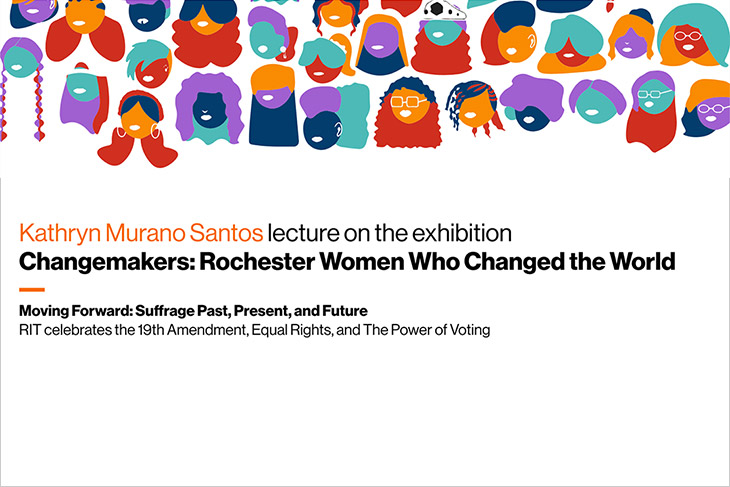Rochester Museum & Science Center exhibit includes content developed by RIT alumni
Exhibit preview and talk will be held via Zoom Nov. 12
RIT alumni contributed to a major exhibition at the Rochester Museum & Science Center highlighting Rochester and Haudenosaunee women who pushed for social change.
“The Changemakers: Rochester Women Who Changed the World,” opening Nov. 20, includes content developed by Monica Conary ’20 (museum studies; sociology and anthropology), James Kane ’20 (fine art photography), Lauren Perttula ’20 (graphic design), and Claudia Paulson ’20 (fine art photography). They collaborated with the museum during their senior year at RIT and after graduation. The opportunity grew from project proposals they worked on last fall in Professor Rebecca DeRoo’s Gender and Contemporary Art course in the museum studies program.
The RMSC exhibit celebrates the suffrage centennial of the 19th amendment and highlights more than 200 women, historical and contemporaneous, who have influenced change in Rochester and beyond our community. A virtual preview of the exhibit will be held 12:30 to 1:30 p.m. Nov. 12, and will feature a Zoom webinar lecture by Kathryn Murano Santos, senior director of collections and exhibitions at the RMSC, and comments from the alumni contributors.
Paulson will join the discussion live, and Conary, Kane, and Perttula will present via previously recorded interviews. The webinar is part of RIT’s Moving Forward: Suffrage Past, Present, and Future program and marks 100 years of the 19th amendment, voting rights, and Susan B. Anthony’s 200th birthday. All are invited to join the webinar via the Zoom.
“The RMSC provided the students with exhibition content, but all of the students conducted additional research to develop their exhibition projects,” DeRoo said. “This is a wonderful example of student research having a larger audience and impact. The interactive map will be exhibited within the ‘Changemakers’ exhibition and will also be available online via the RMSC website to provide access to audiences far beyond the region.”
DeRoo, an associate professor in RIT’s School of Communication and museum studies program, is on the committee for the RMSC’s exhibition content development and for RIT’s Moving Forward program. Developing content for the exhibit enabled her students to apply their knowledge beyond the classroom, network with professionals, and add real-world experience to their resumes.
“Being included in parts of the exhibition process was amazing,” said Conary. “I loved going to the meeting and hearing everyone’s opinions and the thought process behind some of the choices that were being made for the exhibition.”
Conary, who is pursuing a Master of Forestry degree at the University of Maine, created a template for an interactive tour. “Interpreters would dress up as a historical figure and take you through the exhibit identifying the inspirational women whose stories are being told,” she said. “I wanted the tour to incorporate a lot of conversation and encourage discussion about the past and the present.”
Kane and Perttula designed brochures that depict the accomplishments of women in the exhibition. Kane, who currently serves with the Washington Conservation Corps (part of AmeriCorps) in Ellensburg, Wash., found value in the exhibition process. “I’ve learned not only about the women who we researched for the brochures, but also the process of creating something for an exhibition,” Kane said. “It was really useful to be part of the whole process and now that’s knowledge I can bring to any future job and/or exhibition.”
Perttula, who works as a graphic designer in Idaho Falls, Idaho, partnered with Kane to create brochures that continue the conversation and connect with the audience. Their materials focused on different women featured in the exhibit, providing an illustration, narrative, and a map of the city identifying their areas of influence in the community. “Because of the focus on local figures, pointing people to local places allows visitors to dig further into their own community,” Perttula said. “The hope is for connection and interaction with the past and present, to inspire our future changemakers.”
Paulson’s interactive map includes hundreds of individuals. It highlights women’s accomplishments, features photographs, and provides links to regional sites where the women achieved social change. Paulson currently works as a digital content coordinator in Yakima, Wash., where she manages social media campaigns and conducts community outreach programs.
“The staff at the RMSC hired diversity consultants to create an accurate and inclusive exhibition,” Paulson said. “With the diversity consultants’ feedback on exhibit content and the lessons taught by Dr. Rebecca DeRoo’s Gender and Contemporary Art, I was provided with amazing resources and information to create the interactive map element for the exhibition.”
In addition to creating content, Paulson observed how the professionals at the museum dealt with the changing circumstances and unknowns of the public health crisis while trying to plan for a large exhibition. “As we all worked together, I was able to see them push through the many challenges that the COVID-19 pandemic presented. They showed up to our virtual meetings ready to conquer the next task,” she said. “Their support gave me the reassurance and guidance I was looking for after having graduated in the middle of a pandemic.”
Support from the College of Liberal Arts helped the students continue their project last spring. Additional funding this fall from the Moving Forward: Suffrage Past, Present, and Future enabled Paulson to complete her interactive map.













